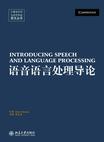语音语言处理导论
2010-8
北京大学出版社
John Coleman
301
无
计算语言学《iotaputational Linguistics,CL)在语言科学与信息科学的研究领域扮演关键性的角色。语言学理论寻求对语言现象规律性的揭示与完整的解释。计算语言学正好提供了验证与应用这些规律与解释的大好机会。作为语言学、信息科学乃至于心理学与认知科学结合的交叉学科,计算语言学更提供了语言学基础研究与应用研究的绝佳界面。事实上,计算语言学与人类语言科技(Human Language Technology,HLT)可以视为一体两面,不可分割。 计算语言学研究滥觞于上世纪五六十年代的机器翻译研究。中文的相关研究也几乎同步开始,1960年起在柏克莱加州大学研究室,王士元、邹嘉彦、C.Y.Dougherty等人已开始研究中英、中俄机器翻译。他们的中文计算语言学研究,可说是与世界最尖端科技同步的。中国国内中俄翻译研究也不遑多让,大约在上世纪50年代中期便已开始。可惜的是,这些中文相关早期机器翻译研究,由于硬件与软件的限制,没能延续下来。中文计算语言学研究比较有系统的进展,还要等到1986年;海峡两岸在同一年成立了两个致力于中文计算语言学基础架构建立的研究群。北京大学的计算语言学研究所在朱德熙先生倡导下成立,随后一段时间由陆俭明、俞士汶主持。而台湾“中研院”的中文词知识库小组,由谢清俊创立,陈克健主持,黄居仁1987年返台后加入。
中国国内中俄翻译研究也不遑多让,大约在上世纪50年代中期便已开始。可惜的是,这些中文相关早期机器翻译研究,由于硬件与软件的限制,没能延续下来。中文计算语言学研究比较有系统的进展,还要等到1986年;海峡两岸在同一年成立了两个致力于中文计算语言学基础架构建立的研究群。北京大学的计算语言学研究所在朱德熙先生倡导下成立,随后一段时间由陆俭明、俞士汶主持。而台湾“中研院”的中文词知识库小组,由谢清俊创立,陈克健主持,黄居仁1987年返台后加入。
导读Acknowledgements and copyright notices1 Introduction1.1 About this book1.2 Purpose of this book1.3 Some reasons to use this book1.4 What's in the book (and what's not)1.5 Computational set-up needed for this book1.6 Computational skills that are necessary in order to use the book1.7 Free software suggestions1.8 Book structureSounds and numbers2.1 Preparatory assignments2.2 Solutions2.3 Sampling2.4 Quantization2.5 The sampling theorem2.6 Generating a signal2.7 Numeric data types2.8 The program2.9 Structure of a loop2.10 Structure of an array2.11 Calculating the cosine values2.12 Structure of the program2.13 Writing the signal to a fileChapter summaryFurther ExercisesFurther readingDigital filters and resonators3.1 Operations on sequences of numbers3.2 A program for calculating RMS amplitude3.3 Filtering3.4 A program for calculating running means of 43.5 Smoothing over a longer time-window3.6 Avoiding the need for long window 3.7 IIR filters in C3.8 Structure of the Klatt formant synthesizerChapter summaryExercisesFurther reading Frequency analysis and linear predictive coding4.1 Spectral analysis4.2 Spectral analysis in C4.3 Cepstral analysis4.4 Computation of the cepstrum in C4.5 Pitch tracking using cepstral analysis4.6 Voicing detection4.7 f0estimation by the autocorrelation method4.8 Linear predictive coding4.9 C programs for LPC analysis and resynthesis4.10 Trying it out4.11 Applications of LPCChapter SummaryFurther exercisesFurther readingFinite-state machines5. 1 Some simple examples5.2 A more serious example5.3 Deterministic and non-deterministic automata5.4 Implementation in Prolog5.5 Prolog's processing strategy and the treatmentof variables5.6 Generating strings5.7 Three possibly useful applications o{ that idea5.8 Another approach to describing finite-state machines5.9 Self-loops5.10 Finite-state transducers(FSTs)5.11 Using finite-state transducers to relate speech to phonemes5.12 Finite-state phonology5.13 Finite-state syntactic processingChapter summaryFurther exercisesFurther readingIntroduction to speech recognition techniques6.1 Architectures for speech recognition6.2 The pattern-recognition approach6.3 Dynamic time warping6.4 Applications6.5 Sources of variability in speechChapter summaryFurther readingProbabilistic finite-state models7.1 Introduction7.2 Indeterminacy: n-gram models for part-of-speech tagging ~7.3 Some probability theory for language modelling7.4 Markov models7.5 Trigram models7.6 Incompleteness of the training corpus7.7 Part-of-speech model calculations7.8 Using HMMs for speech recognition7.9 Chomsky's objections to Markov models and some rejoindersChapter summaryFurther readingParsing8.1 Introduction8.9 A demo8.3 Intuitive parsing8.4 Recursive descent parsing8.5 The simplest parsing program8.6 Difference lists8.7 Generating a parse tree8.8 Syllabification8.9 Other parsing algorithms8.10 Chart parsing8.11 Depth-first vs. breadth-first search8.19 Deterministic parsing, Marcus parsing and minimal commitment parsing8.13 Parallel parsingChapter summaryFurther readingUsing probabilistie grammars9.1 Motivations9.2 Probabilistic context-free grammars9.3 Estimation of rule probabilities9.4 A practical example9.5 A limitation of probabilistic context-free grammars9.6 Tree adjoining grammars……
语音和语言处理都以人类语言为处理对象,但处理的层面却不相同。语音处理关注的是利用计算机对语音信号进行分析和综合,从而实现合成和识别人类语音。而语言处理更多关注对人类语言的句法、语义进行建模,终极目标是实现人类语言的机器理解。 尽管语音处理和语言处理的对象都是人类语言,不过传统上这是两个相互独立的学科,这两个领域的研究和教学也是独立进行的,教科书内容通常也不交叉。不过近年来,随着这两个学科的进一步发展,它们之间的关系变得日益密切,两个学科之间的联系越来越受到人们的重视。人们越来越意识到,对于语言理解而言,语音特征绝非没有价值。反过来,语音处理研究也需要关注语言处理的进展,将语言处理的成果应用到语音识别和语音合成研究,有利于提升语音处理的性能。此外,这两个学科在方法论方面也有共性,相互影响和借鉴的情况也时有发生。例如,在20世纪80年代,隐马尔可夫模型被用来解决词性自动标注问题,就是受到该模型应用在语音识别研究中获得成功的启发,尤其值得一提的是,隐马尔可夫模型引入语言处理领域所产生的影响决不是局部性的,它带动了以语料库为基础的经验主义方法在语言处理领域的全面复苏,有着十分重要的意义。这些事例说明,语音和语言处理正在日趋交叉和融合,未来的相关研究和开发需要对这两个领域都有相当理解和把握的人才。 ……

无